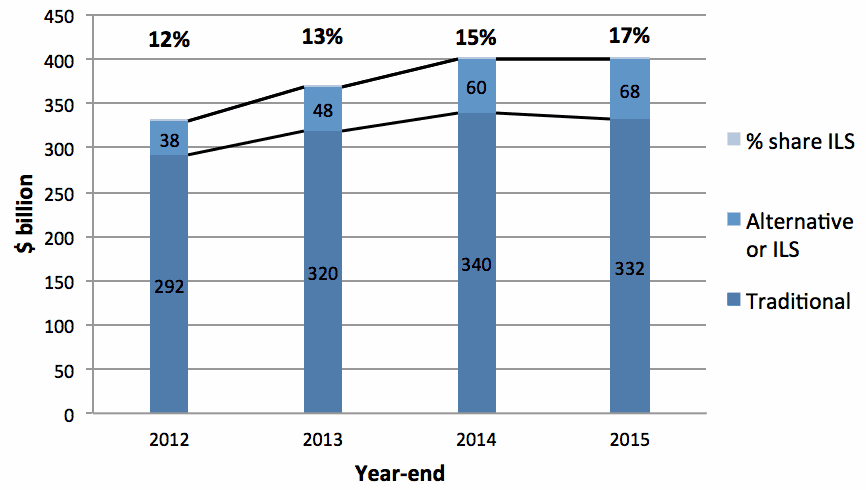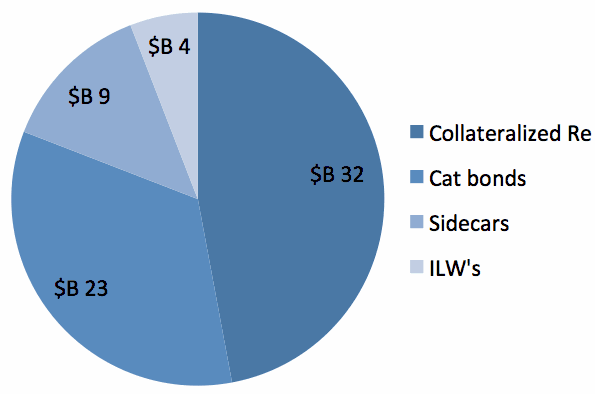Global dedicated reinsurance capital is seen as stable at $400 billion, by Guy Carpenter, the same level seen a year earlier. However the mix between traditional or rated reinsurer capital and alternative markets or ILS has changed, with the ILS market growing its share.
 Over the last year the growth of insurance-linked securities (ILS) and alternative, or convergence, capital slowed, but the evolution of reinsurance capital shows that the lower-cost, efficient capacity direct from the capital markets is becoming increasingly influential.
Over the last year the growth of insurance-linked securities (ILS) and alternative, or convergence, capital slowed, but the evolution of reinsurance capital shows that the lower-cost, efficient capacity direct from the capital markets is becoming increasingly influential.
Reinsurance broker Guy Carpenter along with rating agency A.M. Best, provide estimates on global reinsurance capital and the data shows ILS and the alternative market increasing its size, while the traditional capital has shrunk over the last year. The estimates are calculated by reviewing A.M. Best’s proprietary capital model (BCAR) results as well as line of business allocations.
Now, there are many reasons for this, including traditional reinsurers returning capital to shareholders, expanding into primary lines and also recent M&A activity can tend to slow outright growth of capital, but the main reason is likely down to cost-of-capital and efficiency.
With many reinsurance lines of business approaching reinsurers’ cost-of-capital, more efficient ILS capacity has had a chance to take market share away in some key areas. Also with reinsurers consolidating the pack has shrunk a little, providing the larger ILS fund managers with a chance to step up and fill places on renewals.
There has also been a bit of a rotation going on in reinsurance renewals of late, with some smaller players such as Lloyd’s syndicates finding it harder to gain signings, while some larger ILS players have been able to replace them.
These are all factors that have helped to drive the growth reinsurance market share of ILS and alternative capital.
Speaking today at a press briefing held in London, Nick Frankland, CEO of Guy Carpenter’s EMEA operations, set the scene with an overview of the general trend seen at the January renewals.
“The January 2016 renewal, to our mind, was an orderly, stable very business like renewal,” Frankland said.
“Prices were generally lower than in the previous year, but the decrease was at a slower rate than previously. The amount of reinsurance capital was broadly stable, but capacity still exceeded demand and overall more limits were purchased,” he continued.
Richard Hewitt, Head of Business Intelligence at Guy Carpenter, went on to explain some of the trends in reinsurance capital and how the mix of capital has changed over time.
“We estimate that the dedicated reinsurance capital at the end of 2015 was stable compared to the end of 2014 at $400 billion. And that comes after increasing at a 10% per annum compound rate in the previous two years,” Hewitt said.
“Of that $400 billion, we estimate that 83% was traditional reinsurance capital and this declined by 2% in this past year. However that was perfectly offset by 13% growth in convergence capital,” he continued.
Hewitt said that there were two main factors driving the decrease in traditional reinsurance capital in 2015. Composite re/insurance groups have been switching more capacity to primary lines and reinsurers buying more retrocession from convergence market sources, which also explains some of the growth of ILS capital.
Looking at the change in global reinsurance capital mix over recent years, two things are clear. One, ILS capital continues to grow and two, its market share of global reinsurance is growing and is perhaps pushing some traditional capital out now.

The reinsurance capital mix and ILS or alternative capital's growing market share
So ILS, while slowing its own growth as discipline has been evident and ILS fund managers have slowed down the rate of inflows, has continued to take away share from the traditional reinsurers, to now contribute an estimated 17% of dedicated global reinsurance capital, according to Guy Carpenter and A.M. Best’s figures.
This once again raises a question related to capital efficiency and excess capital. Are we now at a stage in the market cycle where ILS capital can really exert its lower-cost, to continue to gain market share from traditional reinsurers, as they are increasingly forced to look elsewhere for opportunities that meet their return requirements?
Hewitt went on to discuss the breakdown of alternative and ILS capacity. He cited the 13% increase of alternative capital, from $60 billion to $68 billion, which while a slower compound growth rate still impressive in the current competitive reinsurance market environment.
Within the $68 billion there was strong growth of collateralized reinsurance products, which accounted for $32 billion of the total and grew by $5 billion (or 19%) to now make up a 47% share of the total convergence capital. Guy Carpenter sees catastrophe bond capital at $23 billion, which is static with its figure from a year earlier (34% share).
Meanwhile it is reinsurance sidecar vehicles which provided the most growth, within the alternative or convergence capital bracket, increasing by $2 billion to contribute $9 billion of convergence capital (a 13% share), 29% growth over the year.
Finally, industry loss warranties (ILW’s) now contribute $4 billion of convergence capital.

The breakdown of convergence or ILS capital at the end of 2015
The compound growth rate that you saw in 2013/14 for the growth of alternative capital was around double the rate seen today, Hewitt noted, a “quite significant slowdown in the growth of convergence capital.”
So the insurance-linked securities (ILS) and convergence capital markets continue to exert increasing influence. That influence will increase in future renewals, as the percentage of global reinsurance capital wielded by the ILS market increases.
It seems likely that further gains in market share will be seen in the years to come, in fact there may already have been some at the January renewal. As opportunities allow ILS managers to accept new capital inflows, it enables them to put out larger lines, so taking growing shares.
With new reinsurance demand coming from risk pools such as Flood Re and Solvency II also expected to stimulate demand, there is every chance that the collateralised product offered by ILS players and utilised by traditional companies in sidecar vehicles will continue to grow.
Also read:
– Reinsurance rate declines slow, ILS discipline may attract capital: GC.
Read all our reinsurance renewals news and analysis here.
 View all of our Artemis Live video interviews and subscribe to our podcast.
View all of our Artemis Live video interviews and subscribe to our podcast.
All of our Artemis Live insurance-linked securities (ILS), catastrophe bonds and reinsurance video content and video interviews can be accessed online.
Our Artemis Live podcast can be subscribed to using the typical podcast services providers, including Apple, Google, Spotify and more.































